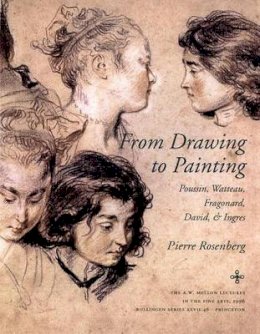
Stock image for illustration purposes only - book cover, edition or condition may vary.
From Drawing to Painting
Pierre Rosenberg
€ 105.26
FREE Delivery in Ireland
Description for From Drawing to Painting
Hardcover. Interweaves biographical information about 5 renowned French artists - Nicolas Poussin, Antoine Watteau, Jean-Honore Fragonard, Jacques-Louis David, and Jean-Auguste-Dominique Ingres. This book presents over 260 illustrations, and explores drawing as a site of reflection, the space between the idea of a painted image and its realization on canvas. Series: The A.W. Mellon Lectures in the Fine Arts. Num Pages: 280 pages, 260 halftones. BIC Classification: 1D; AFC; AFF. Category: (P) Professional & Vocational; (U) Tertiary Education (US: College). Dimension: 225 x 284 x 16. Weight in Grams: 1382.
Pierre Rosenberg, the distinguished art historian and director of the Musee du Louvre, has long admired and studied both paintings and drawings. This dual interest may seem commonplace but is in fact highly unusual: specialists in the field of drawing rarely write about painting, and vice versa. From Drawing to Painting offers a unique perspective by interweaving biographical information about five renowned French artists--Nicolas Poussin, Antoine Watteau, Jean-Honore Fragonard, Jacques-Louis David, and Jean-Auguste-Dominique Ingres--with a fascinating look at dozens of their drawings and the links that they have to their paintings. Presenting over 260 illustrations, this book explores drawing as a site of reflection, the space between the idea of a painted image and its realization on canvas. How, why, and for whom did these artists draw? What value did they place on their drawings? How did their drawings get handed down to us? In what way do they enable us better to understand the artists' intentions, their creative processes, and to penetrate their worlds? Rosenberg determines that each artist approached drawing in a distinctive way, reflecting his individual training, work habits, and personal ambitions. For example, Poussin viewed his drawings simply as working documents, Watteau preferred his drawings to his paintings, and Fragonard made a lucrative business selling his graphic work. For David and Ingres, drawing had a considerable pedagogical function, whether in copying the great works of their predecessors or in sharpening their own techniques. Originally delivered as a series of Mellon Lectures at the National Gallery of Art, Washington, D.C., From Drawing to Painting gives the reader an unprecedented view of the artistic process. This richly illustrated book will make an important and beautiful addition to any art library.
Product Details
Format
Hardback
Publication date
2000
Publisher
Princeton University Press United States
Number of pages
280
Condition
New
Series
The A. W. Mellon Lectures in the Fine Arts
Number of Pages
280
Place of Publication
New Jersey, United States
ISBN
9780691009186
SKU
V9780691009186
Shipping Time
Usually ships in 15 to 20 working days
Ref
99-15
About Pierre Rosenberg
Pierre Rosenberg is honorary president of the Musée du Louvre in Paris, where he was director from 1994 to 2001. A member of the Académie Française, he has published extensively on painting and drawing of the seventeenth and eighteenth centuries and has organized numerous exhibitions throughout the world. His books include Only in America and Chardin.
Reviews for From Drawing to Painting
"Beginning with a general introduction to the background and style of each artist's work, Rosenberg discusses what the drawings meant to each artist, who collected them, how drawings fit into the practice of the creation of paintings, and the tricky practice of attributing drawings."
Library Journal "[A] wonderful, charming and witty book... The scholarship is personable and engaging, yet unobtrusive. A book for everyone, and a model of the unity, and expansiveness, of the art historical enterprise."
Choice "Rosenberg poses in six chapters a series of basic questions on the nature, function, and connoisseurship of drawings. 'Basic' is, or course, a deceptive word, for the most basic questions can be the most challenging to answer. For general audiences, this book ... is the equivalent of a tour with a patient guide through terrain that otherwise might be perceived as rarified or inhospitable... For specialists, this volume of synthesis and reflection will prove a useful complement to the weighty compilations of fact and documentation in the catalogues raisonnes... One can hope that younger scholars will be inspired to follow Rosenberg's example and give equal attention to drawing and painting as two sides of the same coin, as, of course, they are."
Perrin Stein, Master Drawings
Library Journal "[A] wonderful, charming and witty book... The scholarship is personable and engaging, yet unobtrusive. A book for everyone, and a model of the unity, and expansiveness, of the art historical enterprise."
Choice "Rosenberg poses in six chapters a series of basic questions on the nature, function, and connoisseurship of drawings. 'Basic' is, or course, a deceptive word, for the most basic questions can be the most challenging to answer. For general audiences, this book ... is the equivalent of a tour with a patient guide through terrain that otherwise might be perceived as rarified or inhospitable... For specialists, this volume of synthesis and reflection will prove a useful complement to the weighty compilations of fact and documentation in the catalogues raisonnes... One can hope that younger scholars will be inspired to follow Rosenberg's example and give equal attention to drawing and painting as two sides of the same coin, as, of course, they are."
Perrin Stein, Master Drawings
